Report on Developing Individuals, Teams, and Organisation at Tesco
VerifiedAdded on 2020/11/23
|14
|4729
|67
Report
AI Summary
This report delves into the critical aspects of developing individuals, teams, and organizations, focusing on human resource management within the context of Tesco. Section 1 examines the essential knowledge, skills, and behaviors required of a human resource manager, including IT skills, communication, problem-solving, and supervisory management. It also includes a personal skills audit for James, utilizing a SWOT analysis and a personal development plan to identify strengths, weaknesses, opportunities, and threats. The report then analyzes the differences between organizational and individual learning, training, and development, emphasizing the importance of continuous learning for sustainable business performance. Section 2 explores how high-performance workers contribute to employee engagement and competitive advantage. It evaluates various performance management approaches, illustrating their support for a high-performance culture and commitment within an organization. The report concludes by summarizing key findings and insights into fostering a successful and productive work environment.
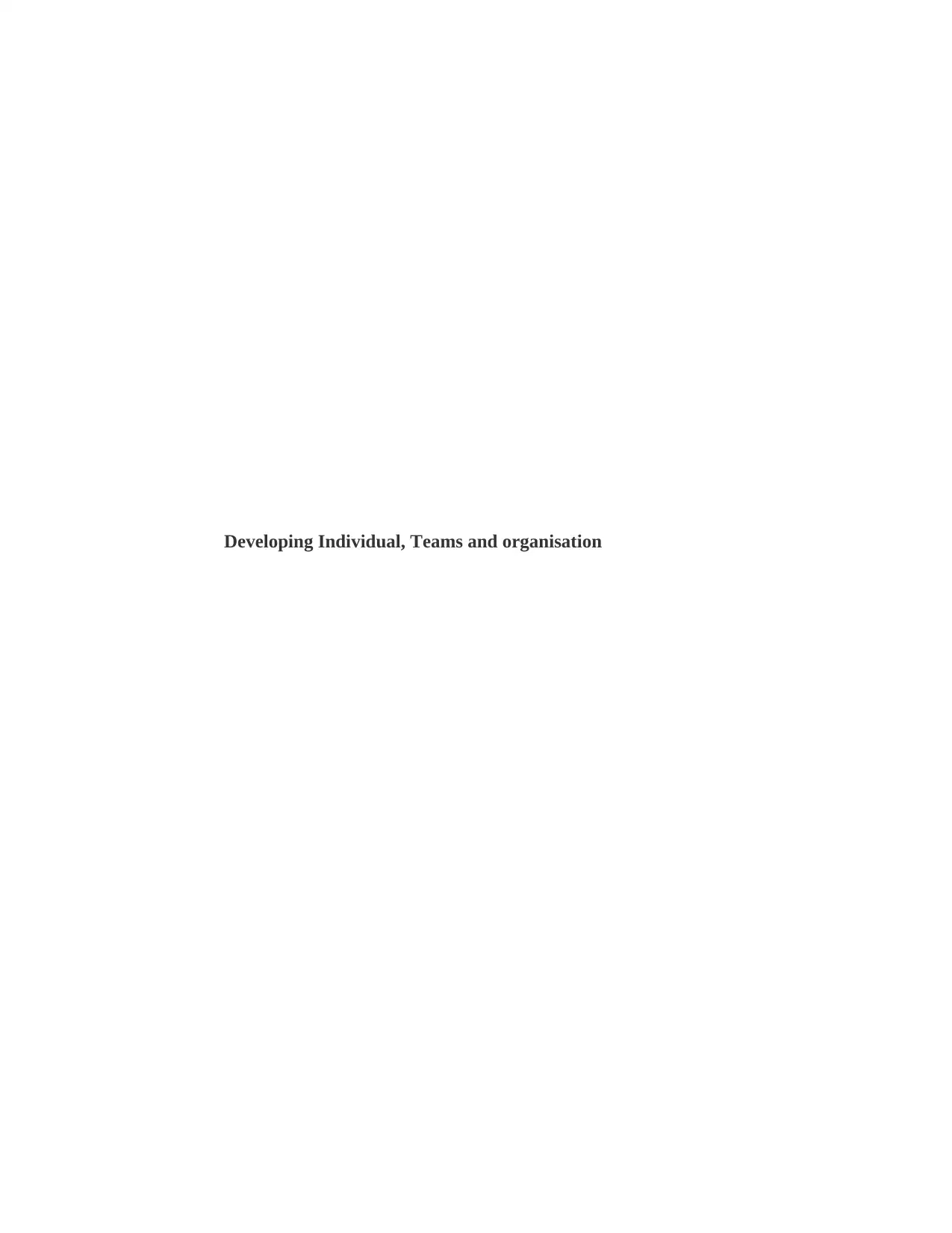
Developing Individual, Teams and organisation
Paraphrase This Document
Need a fresh take? Get an instant paraphrase of this document with our AI Paraphraser
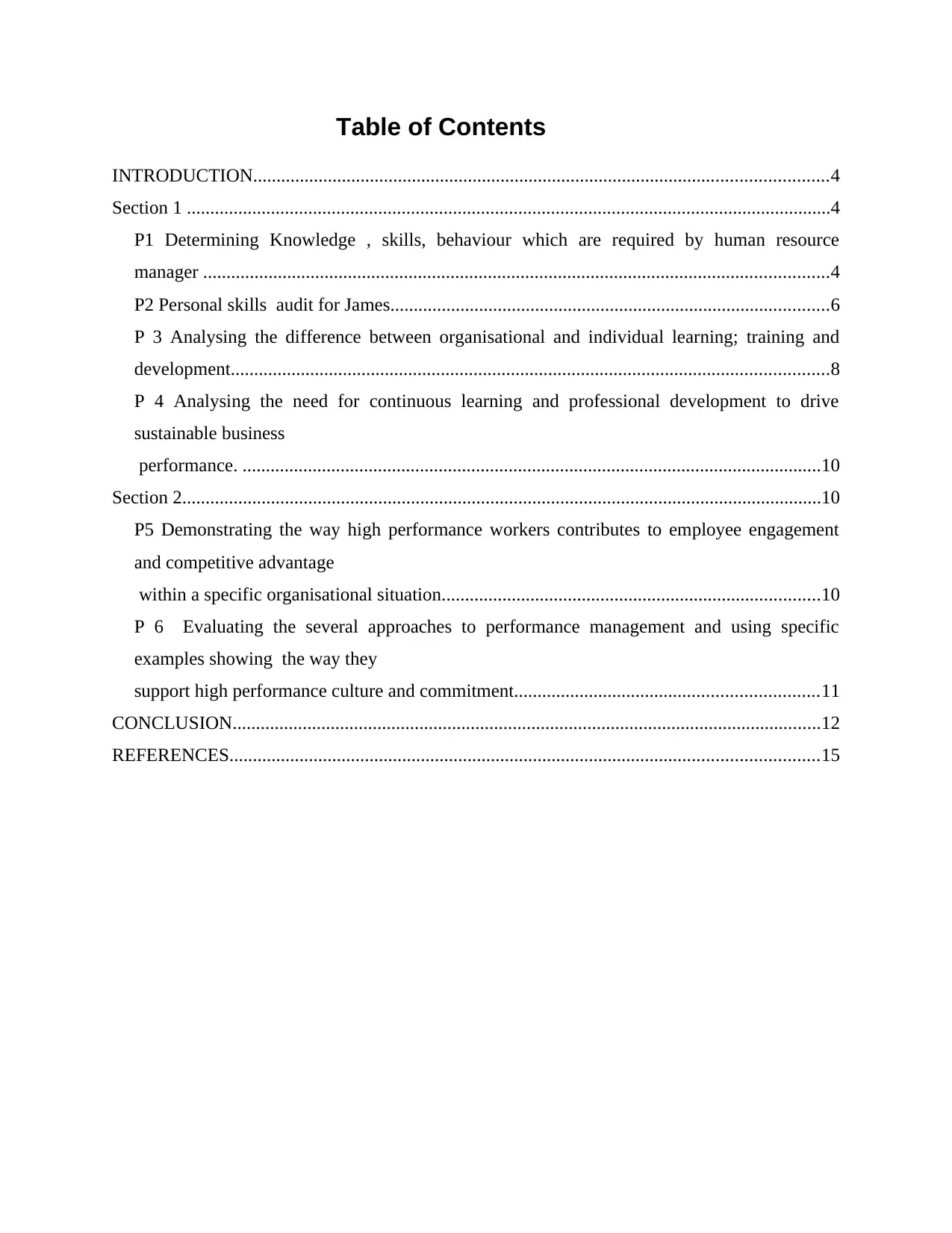
Table of Contents
INTRODUCTION...........................................................................................................................4
Section 1 ..........................................................................................................................................4
P1 Determining Knowledge , skills, behaviour which are required by human resource
manager ......................................................................................................................................4
P2 Personal skills audit for James..............................................................................................6
P 3 Analysing the difference between organisational and individual learning; training and
development................................................................................................................................8
P 4 Analysing the need for continuous learning and professional development to drive
sustainable business
performance. ............................................................................................................................10
Section 2.........................................................................................................................................10
P5 Demonstrating the way high performance workers contributes to employee engagement
and competitive advantage
within a specific organisational situation.................................................................................10
P 6 Evaluating the several approaches to performance management and using specific
examples showing the way they
support high performance culture and commitment.................................................................11
CONCLUSION..............................................................................................................................12
REFERENCES..............................................................................................................................15
INTRODUCTION...........................................................................................................................4
Section 1 ..........................................................................................................................................4
P1 Determining Knowledge , skills, behaviour which are required by human resource
manager ......................................................................................................................................4
P2 Personal skills audit for James..............................................................................................6
P 3 Analysing the difference between organisational and individual learning; training and
development................................................................................................................................8
P 4 Analysing the need for continuous learning and professional development to drive
sustainable business
performance. ............................................................................................................................10
Section 2.........................................................................................................................................10
P5 Demonstrating the way high performance workers contributes to employee engagement
and competitive advantage
within a specific organisational situation.................................................................................10
P 6 Evaluating the several approaches to performance management and using specific
examples showing the way they
support high performance culture and commitment.................................................................11
CONCLUSION..............................................................................................................................12
REFERENCES..............................................................................................................................15
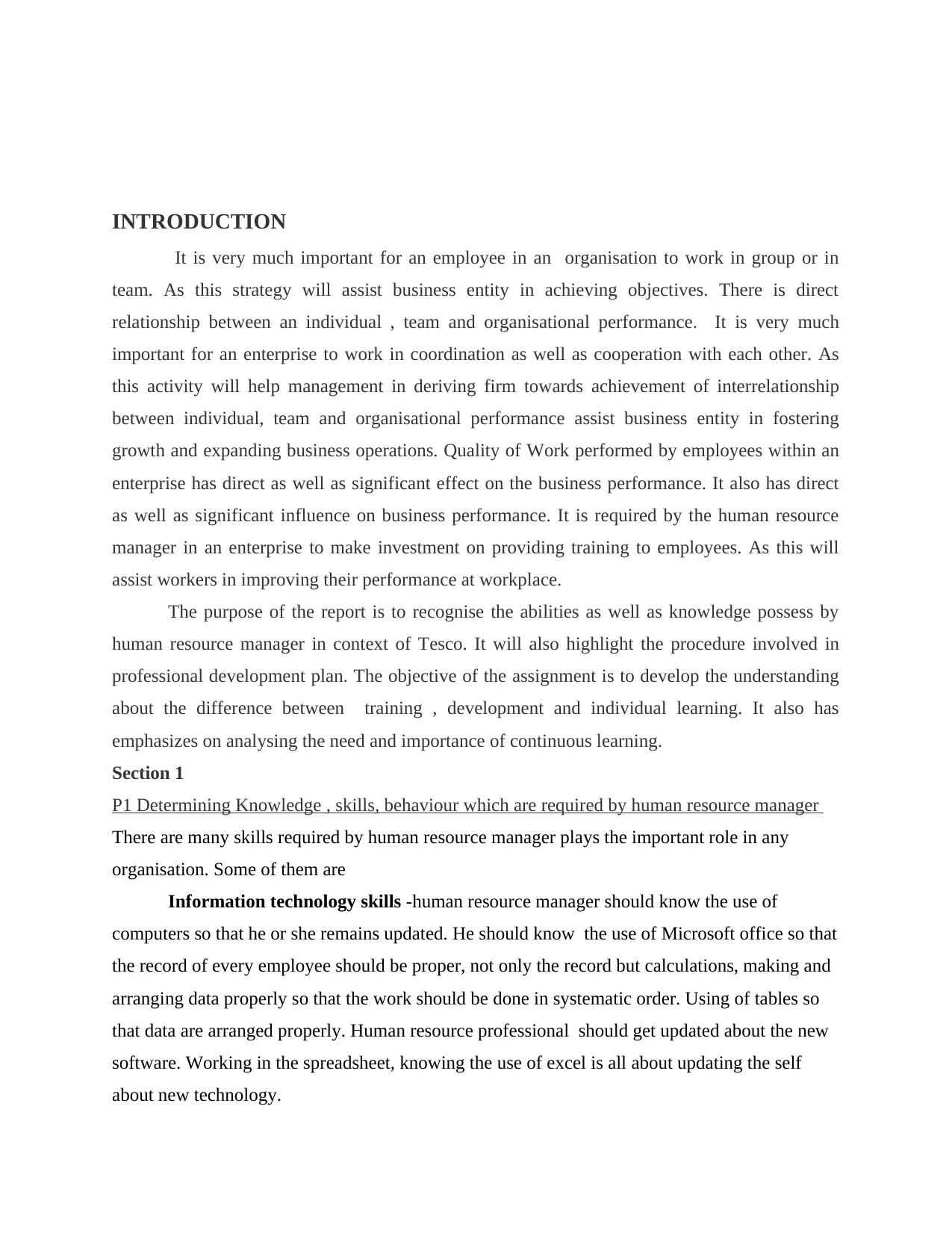
INTRODUCTION
It is very much important for an employee in an organisation to work in group or in
team. As this strategy will assist business entity in achieving objectives. There is direct
relationship between an individual , team and organisational performance. It is very much
important for an enterprise to work in coordination as well as cooperation with each other. As
this activity will help management in deriving firm towards achievement of interrelationship
between individual, team and organisational performance assist business entity in fostering
growth and expanding business operations. Quality of Work performed by employees within an
enterprise has direct as well as significant effect on the business performance. It also has direct
as well as significant influence on business performance. It is required by the human resource
manager in an enterprise to make investment on providing training to employees. As this will
assist workers in improving their performance at workplace.
The purpose of the report is to recognise the abilities as well as knowledge possess by
human resource manager in context of Tesco. It will also highlight the procedure involved in
professional development plan. The objective of the assignment is to develop the understanding
about the difference between training , development and individual learning. It also has
emphasizes on analysing the need and importance of continuous learning.
Section 1
P1 Determining Knowledge , skills, behaviour which are required by human resource manager
There are many skills required by human resource manager plays the important role in any
organisation. Some of them are
Information technology skills -human resource manager should know the use of
computers so that he or she remains updated. He should know the use of Microsoft office so that
the record of every employee should be proper, not only the record but calculations, making and
arranging data properly so that the work should be done in systematic order. Using of tables so
that data are arranged properly. Human resource professional should get updated about the new
software. Working in the spreadsheet, knowing the use of excel is all about updating the self
about new technology.
It is very much important for an employee in an organisation to work in group or in
team. As this strategy will assist business entity in achieving objectives. There is direct
relationship between an individual , team and organisational performance. It is very much
important for an enterprise to work in coordination as well as cooperation with each other. As
this activity will help management in deriving firm towards achievement of interrelationship
between individual, team and organisational performance assist business entity in fostering
growth and expanding business operations. Quality of Work performed by employees within an
enterprise has direct as well as significant effect on the business performance. It also has direct
as well as significant influence on business performance. It is required by the human resource
manager in an enterprise to make investment on providing training to employees. As this will
assist workers in improving their performance at workplace.
The purpose of the report is to recognise the abilities as well as knowledge possess by
human resource manager in context of Tesco. It will also highlight the procedure involved in
professional development plan. The objective of the assignment is to develop the understanding
about the difference between training , development and individual learning. It also has
emphasizes on analysing the need and importance of continuous learning.
Section 1
P1 Determining Knowledge , skills, behaviour which are required by human resource manager
There are many skills required by human resource manager plays the important role in any
organisation. Some of them are
Information technology skills -human resource manager should know the use of
computers so that he or she remains updated. He should know the use of Microsoft office so that
the record of every employee should be proper, not only the record but calculations, making and
arranging data properly so that the work should be done in systematic order. Using of tables so
that data are arranged properly. Human resource professional should get updated about the new
software. Working in the spreadsheet, knowing the use of excel is all about updating the self
about new technology.
⊘ This is a preview!⊘
Do you want full access?
Subscribe today to unlock all pages.

Trusted by 1+ million students worldwide
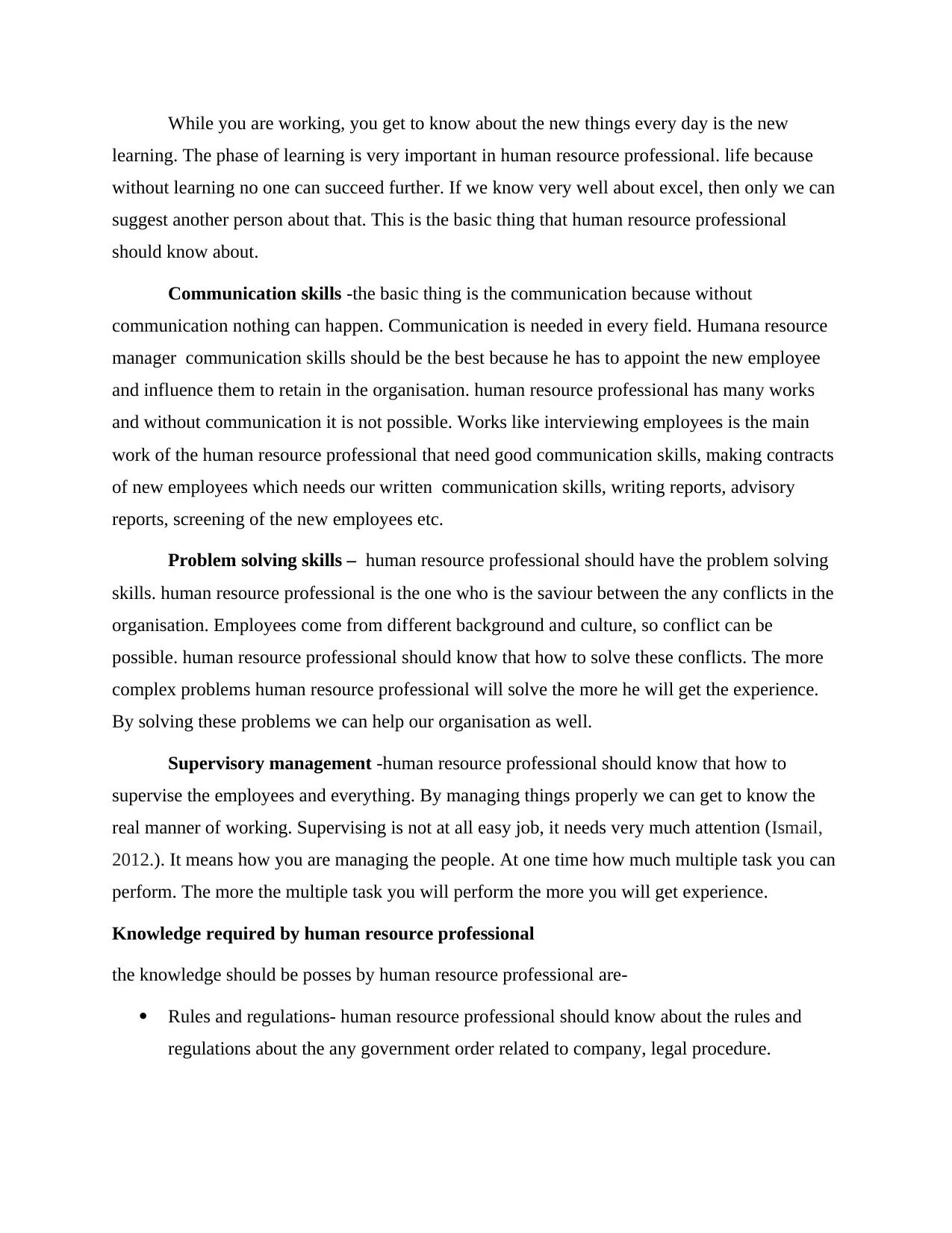
While you are working, you get to know about the new things every day is the new
learning. The phase of learning is very important in human resource professional. life because
without learning no one can succeed further. If we know very well about excel, then only we can
suggest another person about that. This is the basic thing that human resource professional
should know about.
Communication skills -the basic thing is the communication because without
communication nothing can happen. Communication is needed in every field. Humana resource
manager communication skills should be the best because he has to appoint the new employee
and influence them to retain in the organisation. human resource professional has many works
and without communication it is not possible. Works like interviewing employees is the main
work of the human resource professional that need good communication skills, making contracts
of new employees which needs our written communication skills, writing reports, advisory
reports, screening of the new employees etc.
Problem solving skills – human resource professional should have the problem solving
skills. human resource professional is the one who is the saviour between the any conflicts in the
organisation. Employees come from different background and culture, so conflict can be
possible. human resource professional should know that how to solve these conflicts. The more
complex problems human resource professional will solve the more he will get the experience.
By solving these problems we can help our organisation as well.
Supervisory management -human resource professional should know that how to
supervise the employees and everything. By managing things properly we can get to know the
real manner of working. Supervising is not at all easy job, it needs very much attention (Ismail,
2012.). It means how you are managing the people. At one time how much multiple task you can
perform. The more the multiple task you will perform the more you will get experience.
Knowledge required by human resource professional
the knowledge should be posses by human resource professional are-
Rules and regulations- human resource professional should know about the rules and
regulations about the any government order related to company, legal procedure.
learning. The phase of learning is very important in human resource professional. life because
without learning no one can succeed further. If we know very well about excel, then only we can
suggest another person about that. This is the basic thing that human resource professional
should know about.
Communication skills -the basic thing is the communication because without
communication nothing can happen. Communication is needed in every field. Humana resource
manager communication skills should be the best because he has to appoint the new employee
and influence them to retain in the organisation. human resource professional has many works
and without communication it is not possible. Works like interviewing employees is the main
work of the human resource professional that need good communication skills, making contracts
of new employees which needs our written communication skills, writing reports, advisory
reports, screening of the new employees etc.
Problem solving skills – human resource professional should have the problem solving
skills. human resource professional is the one who is the saviour between the any conflicts in the
organisation. Employees come from different background and culture, so conflict can be
possible. human resource professional should know that how to solve these conflicts. The more
complex problems human resource professional will solve the more he will get the experience.
By solving these problems we can help our organisation as well.
Supervisory management -human resource professional should know that how to
supervise the employees and everything. By managing things properly we can get to know the
real manner of working. Supervising is not at all easy job, it needs very much attention (Ismail,
2012.). It means how you are managing the people. At one time how much multiple task you can
perform. The more the multiple task you will perform the more you will get experience.
Knowledge required by human resource professional
the knowledge should be posses by human resource professional are-
Rules and regulations- human resource professional should know about the rules and
regulations about the any government order related to company, legal procedure.
Paraphrase This Document
Need a fresh take? Get an instant paraphrase of this document with our AI Paraphraser
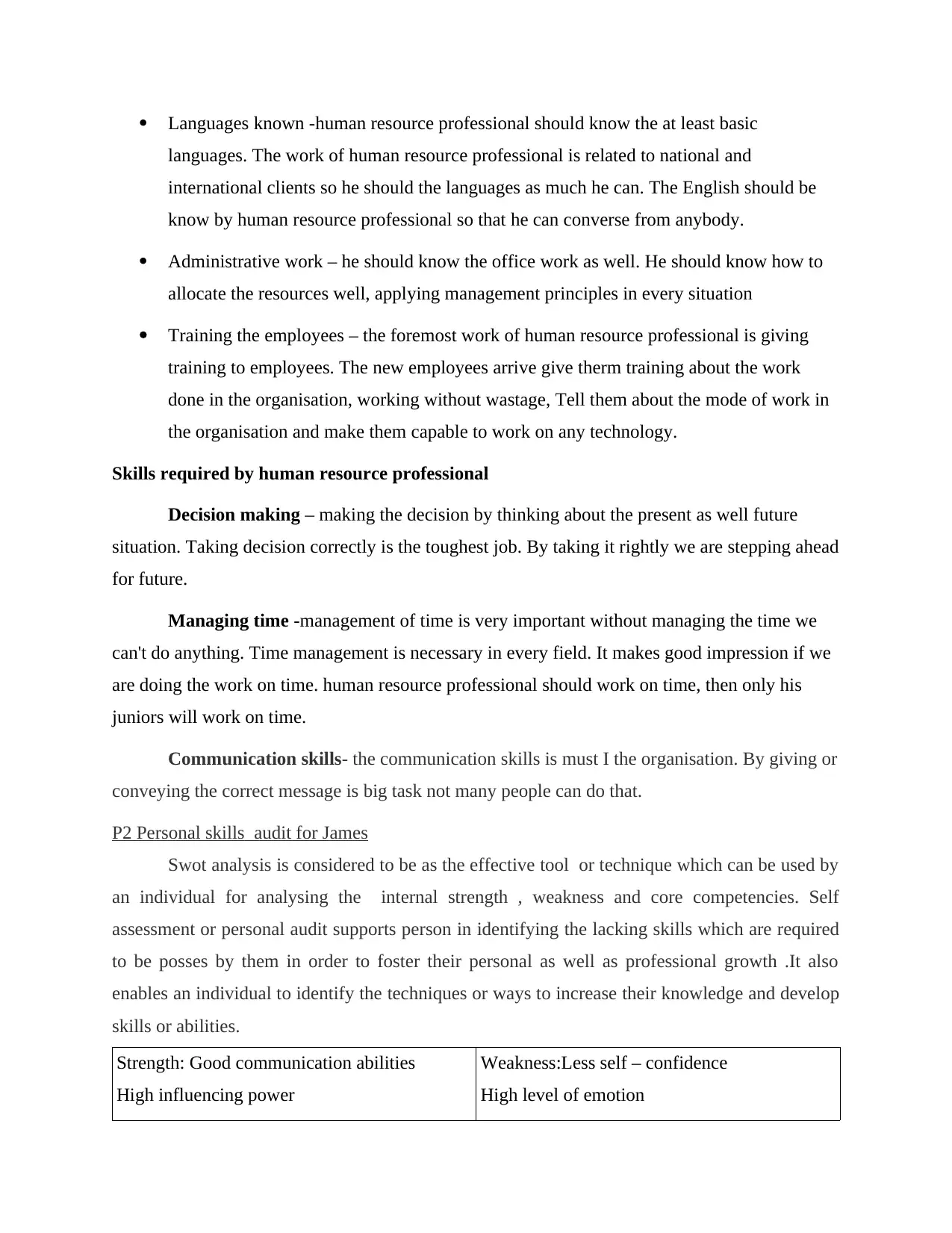
Languages known -human resource professional should know the at least basic
languages. The work of human resource professional is related to national and
international clients so he should the languages as much he can. The English should be
know by human resource professional so that he can converse from anybody.
Administrative work – he should know the office work as well. He should know how to
allocate the resources well, applying management principles in every situation
Training the employees – the foremost work of human resource professional is giving
training to employees. The new employees arrive give therm training about the work
done in the organisation, working without wastage, Tell them about the mode of work in
the organisation and make them capable to work on any technology.
Skills required by human resource professional
Decision making – making the decision by thinking about the present as well future
situation. Taking decision correctly is the toughest job. By taking it rightly we are stepping ahead
for future.
Managing time -management of time is very important without managing the time we
can't do anything. Time management is necessary in every field. It makes good impression if we
are doing the work on time. human resource professional should work on time, then only his
juniors will work on time.
Communication skills- the communication skills is must I the organisation. By giving or
conveying the correct message is big task not many people can do that.
P2 Personal skills audit for James
Swot analysis is considered to be as the effective tool or technique which can be used by
an individual for analysing the internal strength , weakness and core competencies. Self
assessment or personal audit supports person in identifying the lacking skills which are required
to be posses by them in order to foster their personal as well as professional growth .It also
enables an individual to identify the techniques or ways to increase their knowledge and develop
skills or abilities.
Strength: Good communication abilities
High influencing power
Weakness:Less self – confidence
High level of emotion
languages. The work of human resource professional is related to national and
international clients so he should the languages as much he can. The English should be
know by human resource professional so that he can converse from anybody.
Administrative work – he should know the office work as well. He should know how to
allocate the resources well, applying management principles in every situation
Training the employees – the foremost work of human resource professional is giving
training to employees. The new employees arrive give therm training about the work
done in the organisation, working without wastage, Tell them about the mode of work in
the organisation and make them capable to work on any technology.
Skills required by human resource professional
Decision making – making the decision by thinking about the present as well future
situation. Taking decision correctly is the toughest job. By taking it rightly we are stepping ahead
for future.
Managing time -management of time is very important without managing the time we
can't do anything. Time management is necessary in every field. It makes good impression if we
are doing the work on time. human resource professional should work on time, then only his
juniors will work on time.
Communication skills- the communication skills is must I the organisation. By giving or
conveying the correct message is big task not many people can do that.
P2 Personal skills audit for James
Swot analysis is considered to be as the effective tool or technique which can be used by
an individual for analysing the internal strength , weakness and core competencies. Self
assessment or personal audit supports person in identifying the lacking skills which are required
to be posses by them in order to foster their personal as well as professional growth .It also
enables an individual to identify the techniques or ways to increase their knowledge and develop
skills or abilities.
Strength: Good communication abilities
High influencing power
Weakness:Less self – confidence
High level of emotion
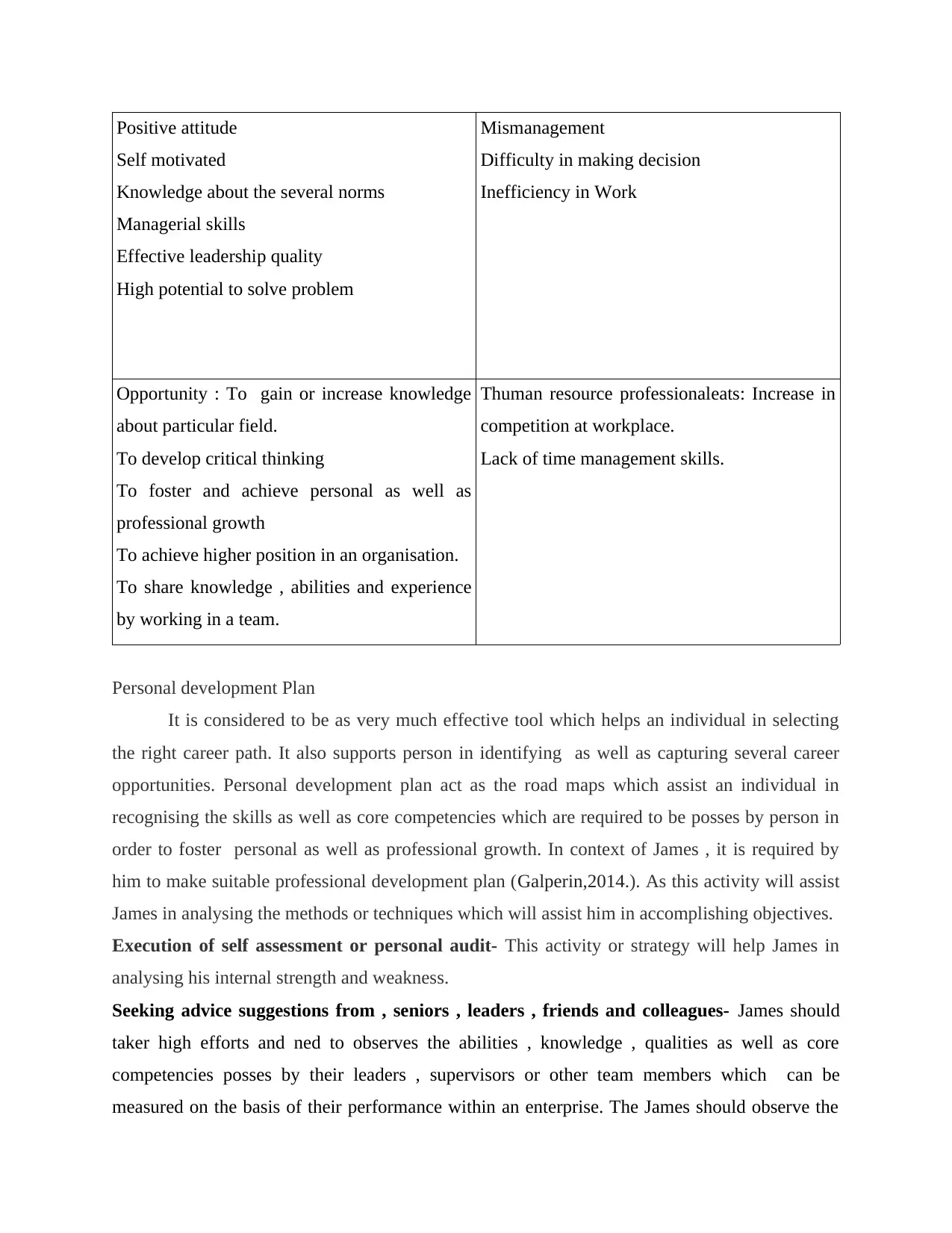
Positive attitude
Self motivated
Knowledge about the several norms
Managerial skills
Effective leadership quality
High potential to solve problem
Mismanagement
Difficulty in making decision
Inefficiency in Work
Opportunity : To gain or increase knowledge
about particular field.
To develop critical thinking
To foster and achieve personal as well as
professional growth
To achieve higher position in an organisation.
To share knowledge , abilities and experience
by working in a team.
Thuman resource professionaleats: Increase in
competition at workplace.
Lack of time management skills.
Personal development Plan
It is considered to be as very much effective tool which helps an individual in selecting
the right career path. It also supports person in identifying as well as capturing several career
opportunities. Personal development plan act as the road maps which assist an individual in
recognising the skills as well as core competencies which are required to be posses by person in
order to foster personal as well as professional growth. In context of James , it is required by
him to make suitable professional development plan (Galperin,2014.). As this activity will assist
James in analysing the methods or techniques which will assist him in accomplishing objectives.
Execution of self assessment or personal audit- This activity or strategy will help James in
analysing his internal strength and weakness.
Seeking advice suggestions from , seniors , leaders , friends and colleagues- James should
taker high efforts and ned to observes the abilities , knowledge , qualities as well as core
competencies posses by their leaders , supervisors or other team members which can be
measured on the basis of their performance within an enterprise. The James should observe the
Self motivated
Knowledge about the several norms
Managerial skills
Effective leadership quality
High potential to solve problem
Mismanagement
Difficulty in making decision
Inefficiency in Work
Opportunity : To gain or increase knowledge
about particular field.
To develop critical thinking
To foster and achieve personal as well as
professional growth
To achieve higher position in an organisation.
To share knowledge , abilities and experience
by working in a team.
Thuman resource professionaleats: Increase in
competition at workplace.
Lack of time management skills.
Personal development Plan
It is considered to be as very much effective tool which helps an individual in selecting
the right career path. It also supports person in identifying as well as capturing several career
opportunities. Personal development plan act as the road maps which assist an individual in
recognising the skills as well as core competencies which are required to be posses by person in
order to foster personal as well as professional growth. In context of James , it is required by
him to make suitable professional development plan (Galperin,2014.). As this activity will assist
James in analysing the methods or techniques which will assist him in accomplishing objectives.
Execution of self assessment or personal audit- This activity or strategy will help James in
analysing his internal strength and weakness.
Seeking advice suggestions from , seniors , leaders , friends and colleagues- James should
taker high efforts and ned to observes the abilities , knowledge , qualities as well as core
competencies posses by their leaders , supervisors or other team members which can be
measured on the basis of their performance within an enterprise. The James should observe the
⊘ This is a preview!⊘
Do you want full access?
Subscribe today to unlock all pages.

Trusted by 1+ million students worldwide
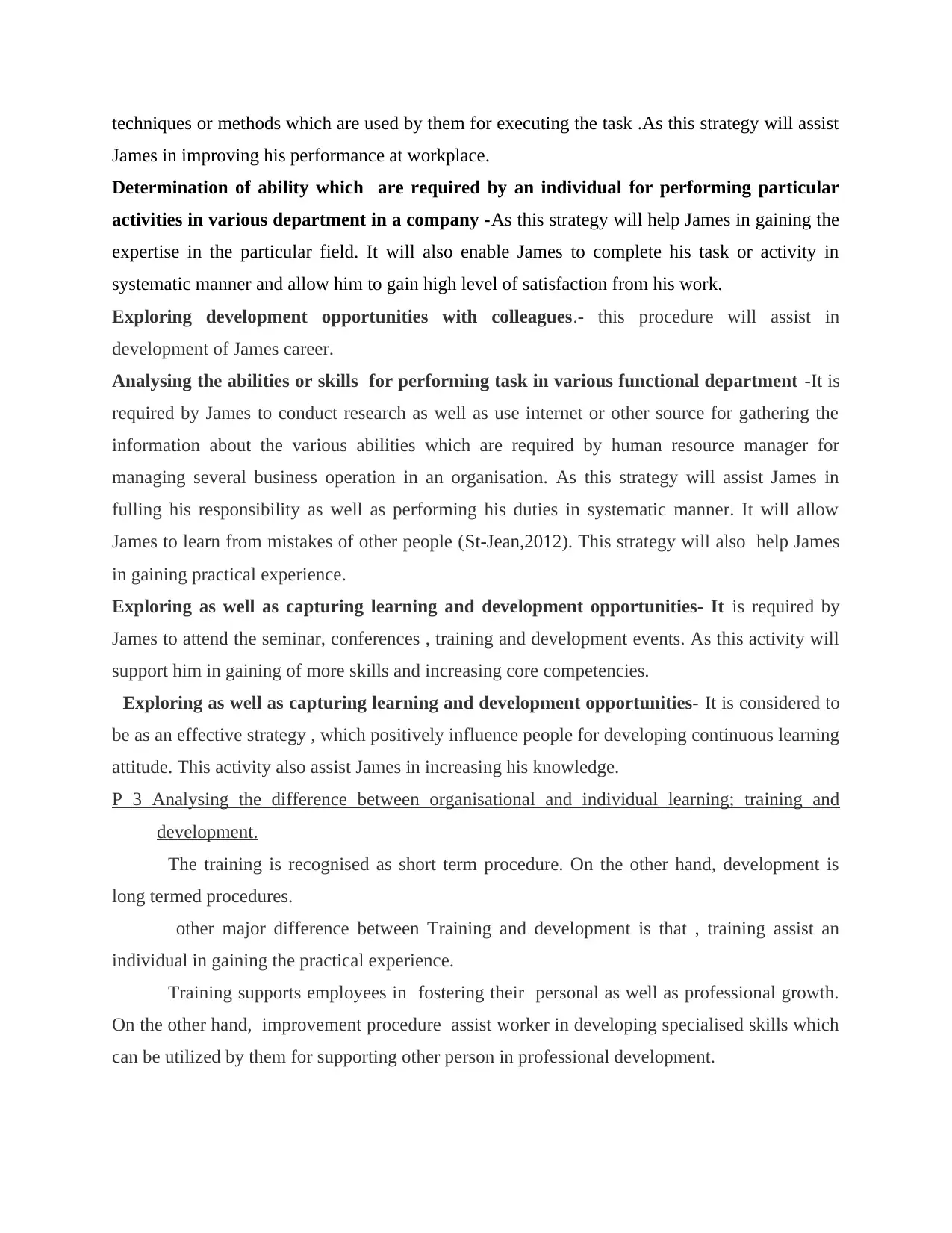
techniques or methods which are used by them for executing the task .As this strategy will assist
James in improving his performance at workplace.
Determination of ability which are required by an individual for performing particular
activities in various department in a company -As this strategy will help James in gaining the
expertise in the particular field. It will also enable James to complete his task or activity in
systematic manner and allow him to gain high level of satisfaction from his work.
Exploring development opportunities with colleagues.- this procedure will assist in
development of James career.
Analysing the abilities or skills for performing task in various functional department -It is
required by James to conduct research as well as use internet or other source for gathering the
information about the various abilities which are required by human resource manager for
managing several business operation in an organisation. As this strategy will assist James in
fulling his responsibility as well as performing his duties in systematic manner. It will allow
James to learn from mistakes of other people (St‐Jean,2012). This strategy will also help James
in gaining practical experience.
Exploring as well as capturing learning and development opportunities- It is required by
James to attend the seminar, conferences , training and development events. As this activity will
support him in gaining of more skills and increasing core competencies.
Exploring as well as capturing learning and development opportunities- It is considered to
be as an effective strategy , which positively influence people for developing continuous learning
attitude. This activity also assist James in increasing his knowledge.
P 3 Analysing the difference between organisational and individual learning; training and
development.
The training is recognised as short term procedure. On the other hand, development is
long termed procedures.
other major difference between Training and development is that , training assist an
individual in gaining the practical experience.
Training supports employees in fostering their personal as well as professional growth.
On the other hand, improvement procedure assist worker in developing specialised skills which
can be utilized by them for supporting other person in professional development.
James in improving his performance at workplace.
Determination of ability which are required by an individual for performing particular
activities in various department in a company -As this strategy will help James in gaining the
expertise in the particular field. It will also enable James to complete his task or activity in
systematic manner and allow him to gain high level of satisfaction from his work.
Exploring development opportunities with colleagues.- this procedure will assist in
development of James career.
Analysing the abilities or skills for performing task in various functional department -It is
required by James to conduct research as well as use internet or other source for gathering the
information about the various abilities which are required by human resource manager for
managing several business operation in an organisation. As this strategy will assist James in
fulling his responsibility as well as performing his duties in systematic manner. It will allow
James to learn from mistakes of other people (St‐Jean,2012). This strategy will also help James
in gaining practical experience.
Exploring as well as capturing learning and development opportunities- It is required by
James to attend the seminar, conferences , training and development events. As this activity will
support him in gaining of more skills and increasing core competencies.
Exploring as well as capturing learning and development opportunities- It is considered to
be as an effective strategy , which positively influence people for developing continuous learning
attitude. This activity also assist James in increasing his knowledge.
P 3 Analysing the difference between organisational and individual learning; training and
development.
The training is recognised as short term procedure. On the other hand, development is
long termed procedures.
other major difference between Training and development is that , training assist an
individual in gaining the practical experience.
Training supports employees in fostering their personal as well as professional growth.
On the other hand, improvement procedure assist worker in developing specialised skills which
can be utilized by them for supporting other person in professional development.
Paraphrase This Document
Need a fresh take? Get an instant paraphrase of this document with our AI Paraphraser
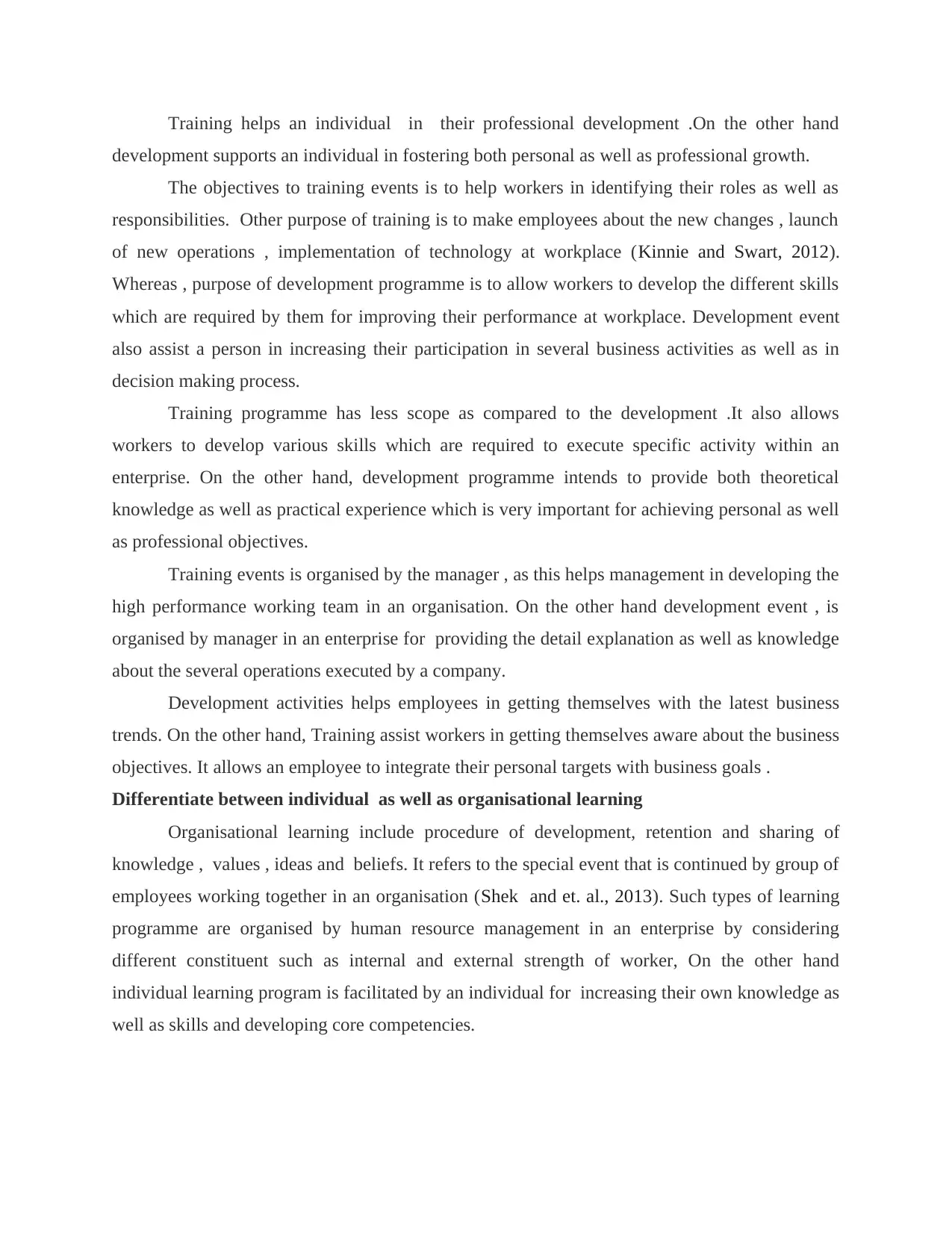
Training helps an individual in their professional development .On the other hand
development supports an individual in fostering both personal as well as professional growth.
The objectives to training events is to help workers in identifying their roles as well as
responsibilities. Other purpose of training is to make employees about the new changes , launch
of new operations , implementation of technology at workplace (Kinnie and Swart, 2012).
Whereas , purpose of development programme is to allow workers to develop the different skills
which are required by them for improving their performance at workplace. Development event
also assist a person in increasing their participation in several business activities as well as in
decision making process.
Training programme has less scope as compared to the development .It also allows
workers to develop various skills which are required to execute specific activity within an
enterprise. On the other hand, development programme intends to provide both theoretical
knowledge as well as practical experience which is very important for achieving personal as well
as professional objectives.
Training events is organised by the manager , as this helps management in developing the
high performance working team in an organisation. On the other hand development event , is
organised by manager in an enterprise for providing the detail explanation as well as knowledge
about the several operations executed by a company.
Development activities helps employees in getting themselves with the latest business
trends. On the other hand, Training assist workers in getting themselves aware about the business
objectives. It allows an employee to integrate their personal targets with business goals .
Differentiate between individual as well as organisational learning
Organisational learning include procedure of development, retention and sharing of
knowledge , values , ideas and beliefs. It refers to the special event that is continued by group of
employees working together in an organisation (Shek and et. al., 2013). Such types of learning
programme are organised by human resource management in an enterprise by considering
different constituent such as internal and external strength of worker, On the other hand
individual learning program is facilitated by an individual for increasing their own knowledge as
well as skills and developing core competencies.
development supports an individual in fostering both personal as well as professional growth.
The objectives to training events is to help workers in identifying their roles as well as
responsibilities. Other purpose of training is to make employees about the new changes , launch
of new operations , implementation of technology at workplace (Kinnie and Swart, 2012).
Whereas , purpose of development programme is to allow workers to develop the different skills
which are required by them for improving their performance at workplace. Development event
also assist a person in increasing their participation in several business activities as well as in
decision making process.
Training programme has less scope as compared to the development .It also allows
workers to develop various skills which are required to execute specific activity within an
enterprise. On the other hand, development programme intends to provide both theoretical
knowledge as well as practical experience which is very important for achieving personal as well
as professional objectives.
Training events is organised by the manager , as this helps management in developing the
high performance working team in an organisation. On the other hand development event , is
organised by manager in an enterprise for providing the detail explanation as well as knowledge
about the several operations executed by a company.
Development activities helps employees in getting themselves with the latest business
trends. On the other hand, Training assist workers in getting themselves aware about the business
objectives. It allows an employee to integrate their personal targets with business goals .
Differentiate between individual as well as organisational learning
Organisational learning include procedure of development, retention and sharing of
knowledge , values , ideas and beliefs. It refers to the special event that is continued by group of
employees working together in an organisation (Shek and et. al., 2013). Such types of learning
programme are organised by human resource management in an enterprise by considering
different constituent such as internal and external strength of worker, On the other hand
individual learning program is facilitated by an individual for increasing their own knowledge as
well as skills and developing core competencies.
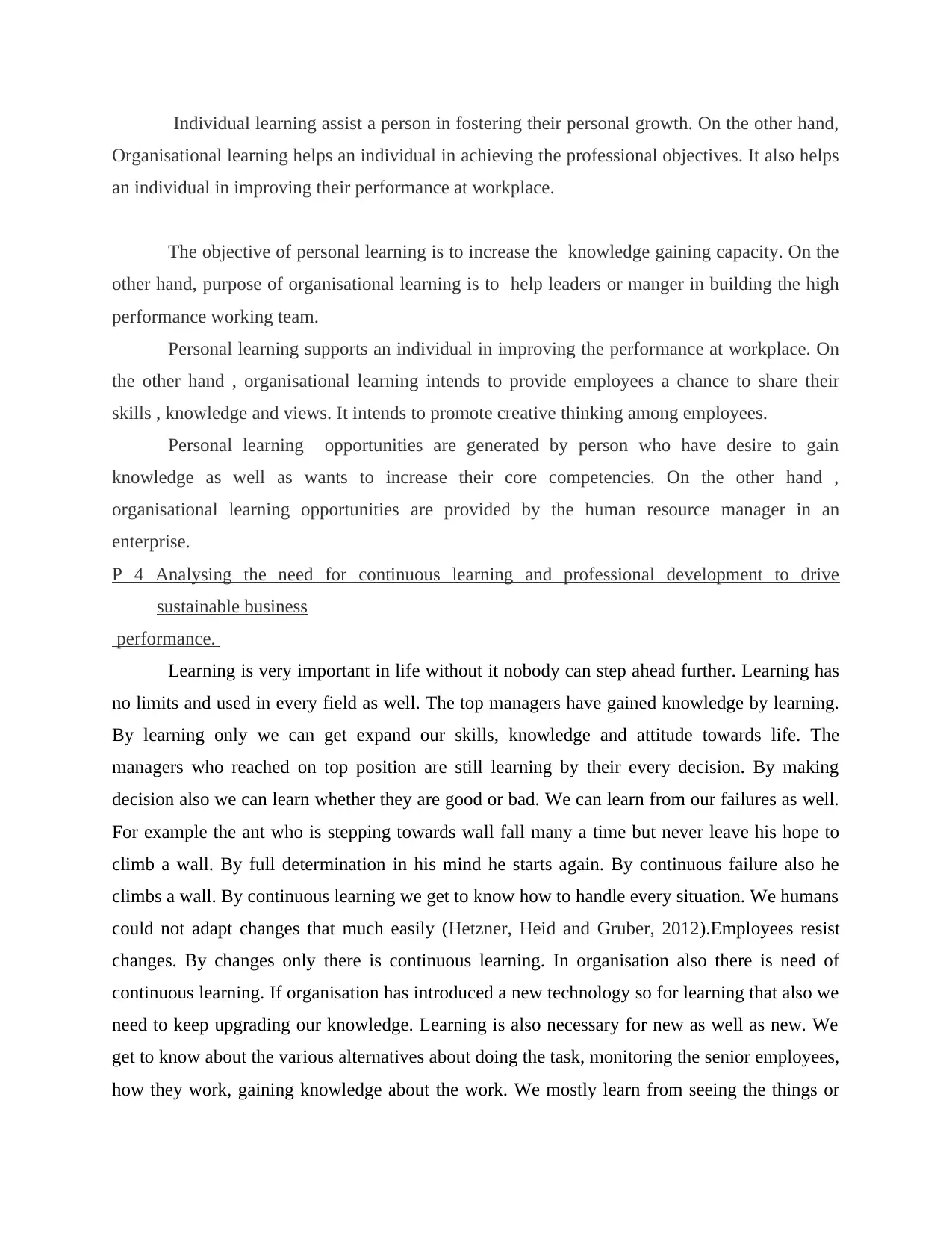
Individual learning assist a person in fostering their personal growth. On the other hand,
Organisational learning helps an individual in achieving the professional objectives. It also helps
an individual in improving their performance at workplace.
The objective of personal learning is to increase the knowledge gaining capacity. On the
other hand, purpose of organisational learning is to help leaders or manger in building the high
performance working team.
Personal learning supports an individual in improving the performance at workplace. On
the other hand , organisational learning intends to provide employees a chance to share their
skills , knowledge and views. It intends to promote creative thinking among employees.
Personal learning opportunities are generated by person who have desire to gain
knowledge as well as wants to increase their core competencies. On the other hand ,
organisational learning opportunities are provided by the human resource manager in an
enterprise.
P 4 Analysing the need for continuous learning and professional development to drive
sustainable business
performance.
Learning is very important in life without it nobody can step ahead further. Learning has
no limits and used in every field as well. The top managers have gained knowledge by learning.
By learning only we can get expand our skills, knowledge and attitude towards life. The
managers who reached on top position are still learning by their every decision. By making
decision also we can learn whether they are good or bad. We can learn from our failures as well.
For example the ant who is stepping towards wall fall many a time but never leave his hope to
climb a wall. By full determination in his mind he starts again. By continuous failure also he
climbs a wall. By continuous learning we get to know how to handle every situation. We humans
could not adapt changes that much easily (Hetzner, Heid and Gruber, 2012).Employees resist
changes. By changes only there is continuous learning. In organisation also there is need of
continuous learning. If organisation has introduced a new technology so for learning that also we
need to keep upgrading our knowledge. Learning is also necessary for new as well as new. We
get to know about the various alternatives about doing the task, monitoring the senior employees,
how they work, gaining knowledge about the work. We mostly learn from seeing the things or
Organisational learning helps an individual in achieving the professional objectives. It also helps
an individual in improving their performance at workplace.
The objective of personal learning is to increase the knowledge gaining capacity. On the
other hand, purpose of organisational learning is to help leaders or manger in building the high
performance working team.
Personal learning supports an individual in improving the performance at workplace. On
the other hand , organisational learning intends to provide employees a chance to share their
skills , knowledge and views. It intends to promote creative thinking among employees.
Personal learning opportunities are generated by person who have desire to gain
knowledge as well as wants to increase their core competencies. On the other hand ,
organisational learning opportunities are provided by the human resource manager in an
enterprise.
P 4 Analysing the need for continuous learning and professional development to drive
sustainable business
performance.
Learning is very important in life without it nobody can step ahead further. Learning has
no limits and used in every field as well. The top managers have gained knowledge by learning.
By learning only we can get expand our skills, knowledge and attitude towards life. The
managers who reached on top position are still learning by their every decision. By making
decision also we can learn whether they are good or bad. We can learn from our failures as well.
For example the ant who is stepping towards wall fall many a time but never leave his hope to
climb a wall. By full determination in his mind he starts again. By continuous failure also he
climbs a wall. By continuous learning we get to know how to handle every situation. We humans
could not adapt changes that much easily (Hetzner, Heid and Gruber, 2012).Employees resist
changes. By changes only there is continuous learning. In organisation also there is need of
continuous learning. If organisation has introduced a new technology so for learning that also we
need to keep upgrading our knowledge. Learning is also necessary for new as well as new. We
get to know about the various alternatives about doing the task, monitoring the senior employees,
how they work, gaining knowledge about the work. We mostly learn from seeing the things or
⊘ This is a preview!⊘
Do you want full access?
Subscribe today to unlock all pages.

Trusted by 1+ million students worldwide
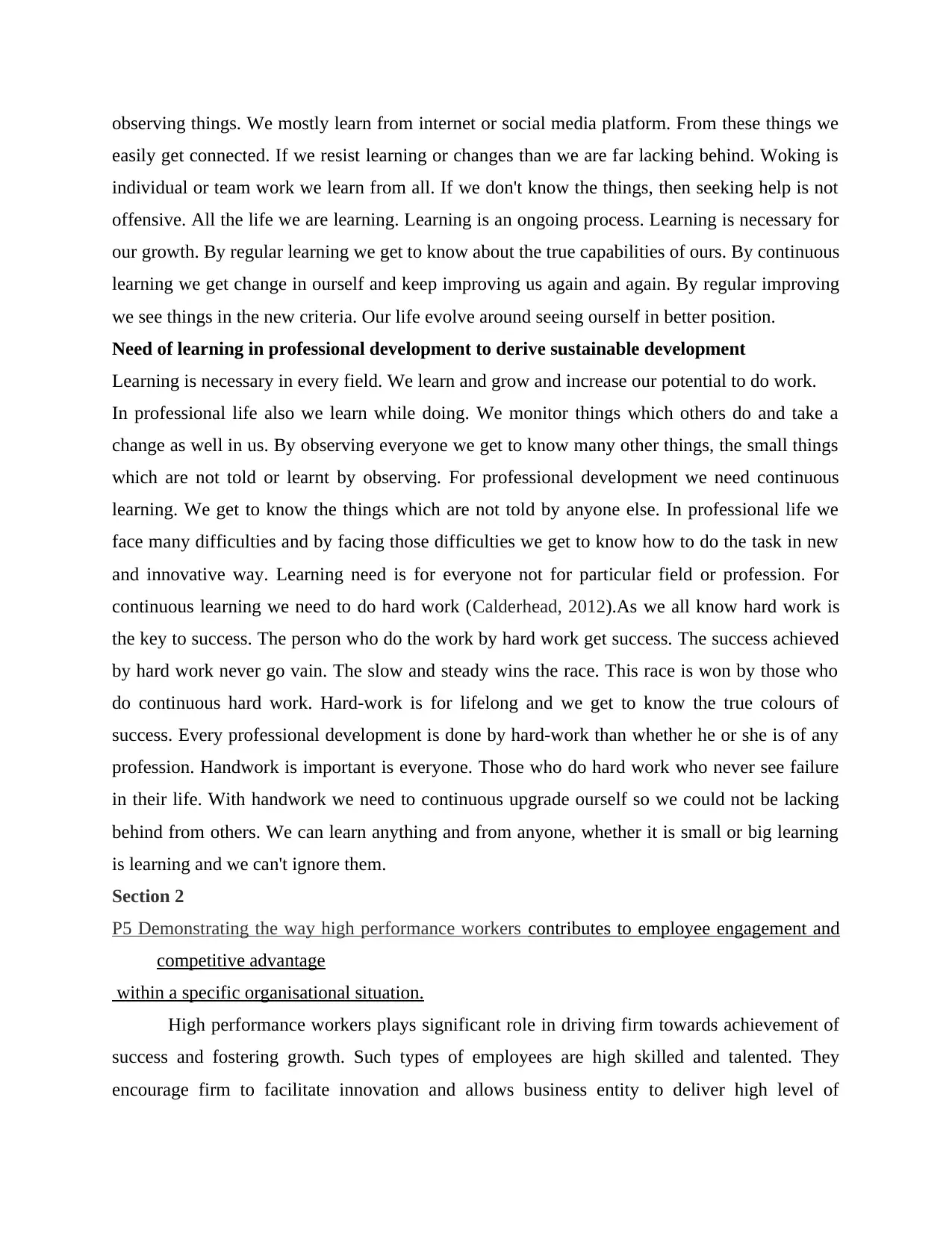
observing things. We mostly learn from internet or social media platform. From these things we
easily get connected. If we resist learning or changes than we are far lacking behind. Woking is
individual or team work we learn from all. If we don't know the things, then seeking help is not
offensive. All the life we are learning. Learning is an ongoing process. Learning is necessary for
our growth. By regular learning we get to know about the true capabilities of ours. By continuous
learning we get change in ourself and keep improving us again and again. By regular improving
we see things in the new criteria. Our life evolve around seeing ourself in better position.
Need of learning in professional development to derive sustainable development
Learning is necessary in every field. We learn and grow and increase our potential to do work.
In professional life also we learn while doing. We monitor things which others do and take a
change as well in us. By observing everyone we get to know many other things, the small things
which are not told or learnt by observing. For professional development we need continuous
learning. We get to know the things which are not told by anyone else. In professional life we
face many difficulties and by facing those difficulties we get to know how to do the task in new
and innovative way. Learning need is for everyone not for particular field or profession. For
continuous learning we need to do hard work (Calderhead, 2012).As we all know hard work is
the key to success. The person who do the work by hard work get success. The success achieved
by hard work never go vain. The slow and steady wins the race. This race is won by those who
do continuous hard work. Hard-work is for lifelong and we get to know the true colours of
success. Every professional development is done by hard-work than whether he or she is of any
profession. Handwork is important is everyone. Those who do hard work who never see failure
in their life. With handwork we need to continuous upgrade ourself so we could not be lacking
behind from others. We can learn anything and from anyone, whether it is small or big learning
is learning and we can't ignore them.
Section 2
P5 Demonstrating the way high performance workers contributes to employee engagement and
competitive advantage
within a specific organisational situation.
High performance workers plays significant role in driving firm towards achievement of
success and fostering growth. Such types of employees are high skilled and talented. They
encourage firm to facilitate innovation and allows business entity to deliver high level of
easily get connected. If we resist learning or changes than we are far lacking behind. Woking is
individual or team work we learn from all. If we don't know the things, then seeking help is not
offensive. All the life we are learning. Learning is an ongoing process. Learning is necessary for
our growth. By regular learning we get to know about the true capabilities of ours. By continuous
learning we get change in ourself and keep improving us again and again. By regular improving
we see things in the new criteria. Our life evolve around seeing ourself in better position.
Need of learning in professional development to derive sustainable development
Learning is necessary in every field. We learn and grow and increase our potential to do work.
In professional life also we learn while doing. We monitor things which others do and take a
change as well in us. By observing everyone we get to know many other things, the small things
which are not told or learnt by observing. For professional development we need continuous
learning. We get to know the things which are not told by anyone else. In professional life we
face many difficulties and by facing those difficulties we get to know how to do the task in new
and innovative way. Learning need is for everyone not for particular field or profession. For
continuous learning we need to do hard work (Calderhead, 2012).As we all know hard work is
the key to success. The person who do the work by hard work get success. The success achieved
by hard work never go vain. The slow and steady wins the race. This race is won by those who
do continuous hard work. Hard-work is for lifelong and we get to know the true colours of
success. Every professional development is done by hard-work than whether he or she is of any
profession. Handwork is important is everyone. Those who do hard work who never see failure
in their life. With handwork we need to continuous upgrade ourself so we could not be lacking
behind from others. We can learn anything and from anyone, whether it is small or big learning
is learning and we can't ignore them.
Section 2
P5 Demonstrating the way high performance workers contributes to employee engagement and
competitive advantage
within a specific organisational situation.
High performance workers plays significant role in driving firm towards achievement of
success and fostering growth. Such types of employees are high skilled and talented. They
encourage firm to facilitate innovation and allows business entity to deliver high level of
Paraphrase This Document
Need a fresh take? Get an instant paraphrase of this document with our AI Paraphraser
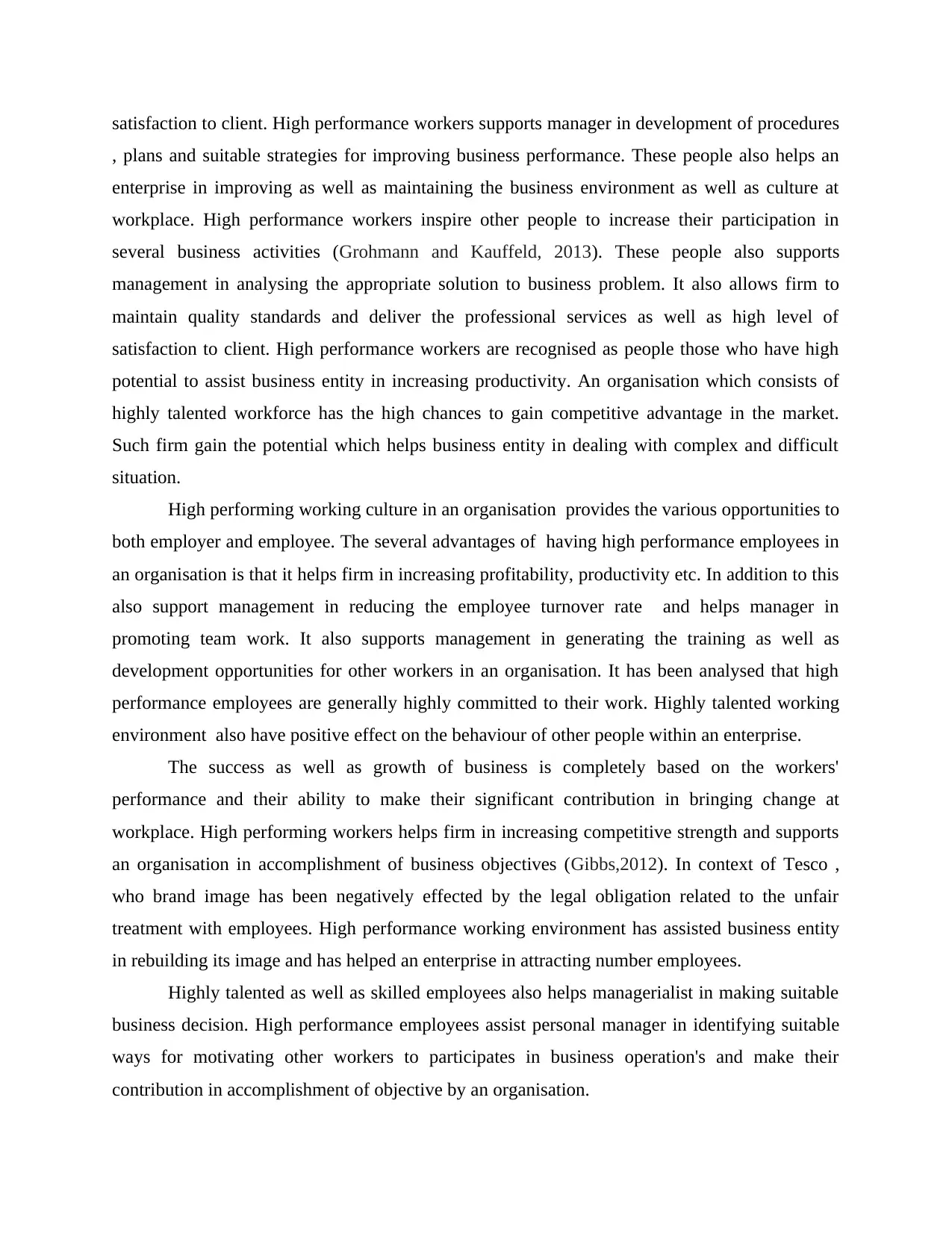
satisfaction to client. High performance workers supports manager in development of procedures
, plans and suitable strategies for improving business performance. These people also helps an
enterprise in improving as well as maintaining the business environment as well as culture at
workplace. High performance workers inspire other people to increase their participation in
several business activities (Grohmann and Kauffeld, 2013). These people also supports
management in analysing the appropriate solution to business problem. It also allows firm to
maintain quality standards and deliver the professional services as well as high level of
satisfaction to client. High performance workers are recognised as people those who have high
potential to assist business entity in increasing productivity. An organisation which consists of
highly talented workforce has the high chances to gain competitive advantage in the market.
Such firm gain the potential which helps business entity in dealing with complex and difficult
situation.
High performing working culture in an organisation provides the various opportunities to
both employer and employee. The several advantages of having high performance employees in
an organisation is that it helps firm in increasing profitability, productivity etc. In addition to this
also support management in reducing the employee turnover rate and helps manager in
promoting team work. It also supports management in generating the training as well as
development opportunities for other workers in an organisation. It has been analysed that high
performance employees are generally highly committed to their work. Highly talented working
environment also have positive effect on the behaviour of other people within an enterprise.
The success as well as growth of business is completely based on the workers'
performance and their ability to make their significant contribution in bringing change at
workplace. High performing workers helps firm in increasing competitive strength and supports
an organisation in accomplishment of business objectives (Gibbs,2012). In context of Tesco ,
who brand image has been negatively effected by the legal obligation related to the unfair
treatment with employees. High performance working environment has assisted business entity
in rebuilding its image and has helped an enterprise in attracting number employees.
Highly talented as well as skilled employees also helps managerialist in making suitable
business decision. High performance employees assist personal manager in identifying suitable
ways for motivating other workers to participates in business operation's and make their
contribution in accomplishment of objective by an organisation.
, plans and suitable strategies for improving business performance. These people also helps an
enterprise in improving as well as maintaining the business environment as well as culture at
workplace. High performance workers inspire other people to increase their participation in
several business activities (Grohmann and Kauffeld, 2013). These people also supports
management in analysing the appropriate solution to business problem. It also allows firm to
maintain quality standards and deliver the professional services as well as high level of
satisfaction to client. High performance workers are recognised as people those who have high
potential to assist business entity in increasing productivity. An organisation which consists of
highly talented workforce has the high chances to gain competitive advantage in the market.
Such firm gain the potential which helps business entity in dealing with complex and difficult
situation.
High performing working culture in an organisation provides the various opportunities to
both employer and employee. The several advantages of having high performance employees in
an organisation is that it helps firm in increasing profitability, productivity etc. In addition to this
also support management in reducing the employee turnover rate and helps manager in
promoting team work. It also supports management in generating the training as well as
development opportunities for other workers in an organisation. It has been analysed that high
performance employees are generally highly committed to their work. Highly talented working
environment also have positive effect on the behaviour of other people within an enterprise.
The success as well as growth of business is completely based on the workers'
performance and their ability to make their significant contribution in bringing change at
workplace. High performing workers helps firm in increasing competitive strength and supports
an organisation in accomplishment of business objectives (Gibbs,2012). In context of Tesco ,
who brand image has been negatively effected by the legal obligation related to the unfair
treatment with employees. High performance working environment has assisted business entity
in rebuilding its image and has helped an enterprise in attracting number employees.
Highly talented as well as skilled employees also helps managerialist in making suitable
business decision. High performance employees assist personal manager in identifying suitable
ways for motivating other workers to participates in business operation's and make their
contribution in accomplishment of objective by an organisation.
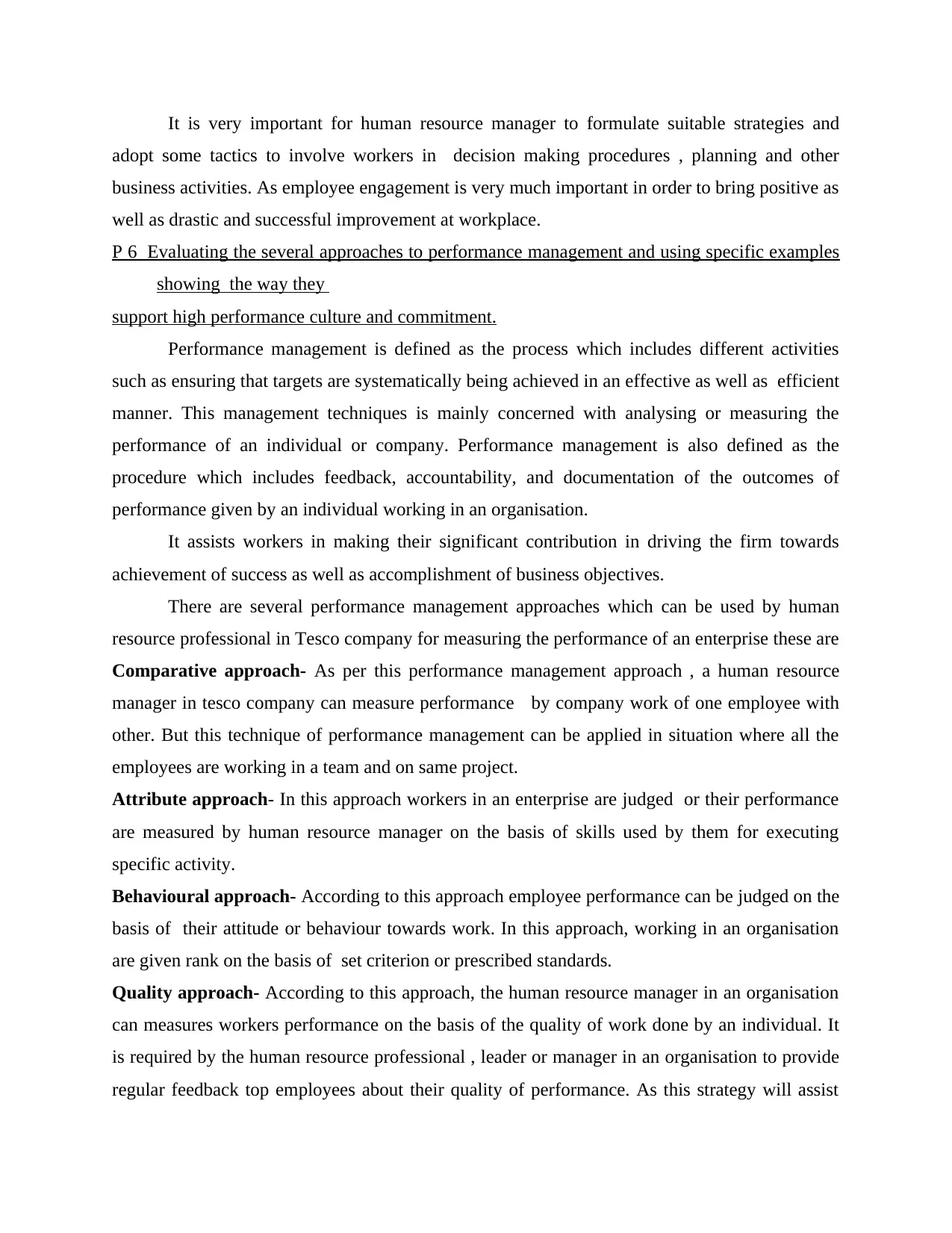
It is very important for human resource manager to formulate suitable strategies and
adopt some tactics to involve workers in decision making procedures , planning and other
business activities. As employee engagement is very much important in order to bring positive as
well as drastic and successful improvement at workplace.
P 6 Evaluating the several approaches to performance management and using specific examples
showing the way they
support high performance culture and commitment.
Performance management is defined as the process which includes different activities
such as ensuring that targets are systematically being achieved in an effective as well as efficient
manner. This management techniques is mainly concerned with analysing or measuring the
performance of an individual or company. Performance management is also defined as the
procedure which includes feedback, accountability, and documentation of the outcomes of
performance given by an individual working in an organisation.
It assists workers in making their significant contribution in driving the firm towards
achievement of success as well as accomplishment of business objectives.
There are several performance management approaches which can be used by human
resource professional in Tesco company for measuring the performance of an enterprise these are
Comparative approach- As per this performance management approach , a human resource
manager in tesco company can measure performance by company work of one employee with
other. But this technique of performance management can be applied in situation where all the
employees are working in a team and on same project.
Attribute approach- In this approach workers in an enterprise are judged or their performance
are measured by human resource manager on the basis of skills used by them for executing
specific activity.
Behavioural approach- According to this approach employee performance can be judged on the
basis of their attitude or behaviour towards work. In this approach, working in an organisation
are given rank on the basis of set criterion or prescribed standards.
Quality approach- According to this approach, the human resource manager in an organisation
can measures workers performance on the basis of the quality of work done by an individual. It
is required by the human resource professional , leader or manager in an organisation to provide
regular feedback top employees about their quality of performance. As this strategy will assist
adopt some tactics to involve workers in decision making procedures , planning and other
business activities. As employee engagement is very much important in order to bring positive as
well as drastic and successful improvement at workplace.
P 6 Evaluating the several approaches to performance management and using specific examples
showing the way they
support high performance culture and commitment.
Performance management is defined as the process which includes different activities
such as ensuring that targets are systematically being achieved in an effective as well as efficient
manner. This management techniques is mainly concerned with analysing or measuring the
performance of an individual or company. Performance management is also defined as the
procedure which includes feedback, accountability, and documentation of the outcomes of
performance given by an individual working in an organisation.
It assists workers in making their significant contribution in driving the firm towards
achievement of success as well as accomplishment of business objectives.
There are several performance management approaches which can be used by human
resource professional in Tesco company for measuring the performance of an enterprise these are
Comparative approach- As per this performance management approach , a human resource
manager in tesco company can measure performance by company work of one employee with
other. But this technique of performance management can be applied in situation where all the
employees are working in a team and on same project.
Attribute approach- In this approach workers in an enterprise are judged or their performance
are measured by human resource manager on the basis of skills used by them for executing
specific activity.
Behavioural approach- According to this approach employee performance can be judged on the
basis of their attitude or behaviour towards work. In this approach, working in an organisation
are given rank on the basis of set criterion or prescribed standards.
Quality approach- According to this approach, the human resource manager in an organisation
can measures workers performance on the basis of the quality of work done by an individual. It
is required by the human resource professional , leader or manager in an organisation to provide
regular feedback top employees about their quality of performance. As this strategy will assist
⊘ This is a preview!⊘
Do you want full access?
Subscribe today to unlock all pages.

Trusted by 1+ million students worldwide
1 out of 14
Related Documents
Your All-in-One AI-Powered Toolkit for Academic Success.
+13062052269
info@desklib.com
Available 24*7 on WhatsApp / Email
![[object Object]](/_next/static/media/star-bottom.7253800d.svg)
Unlock your academic potential
Copyright © 2020–2025 A2Z Services. All Rights Reserved. Developed and managed by ZUCOL.





